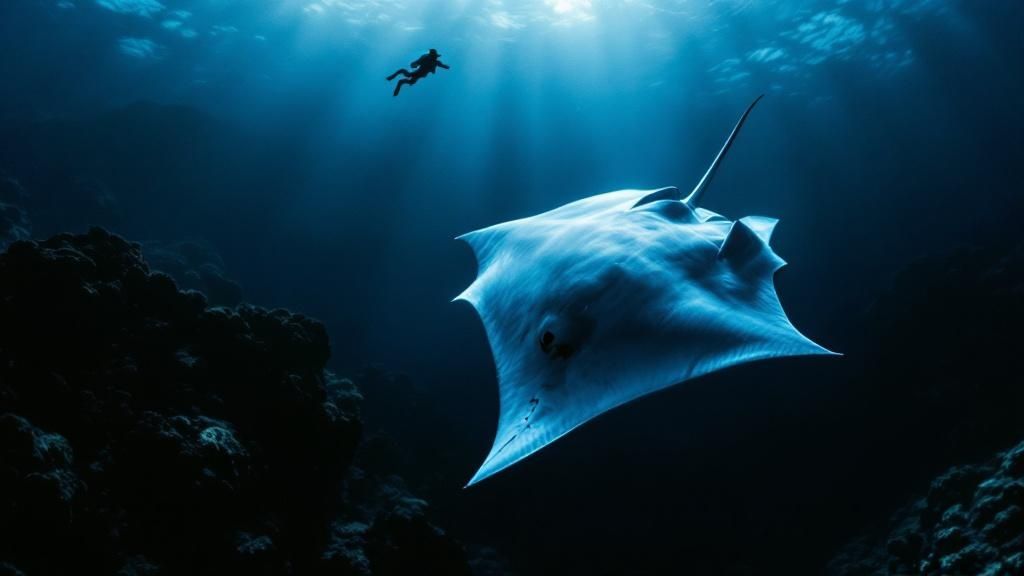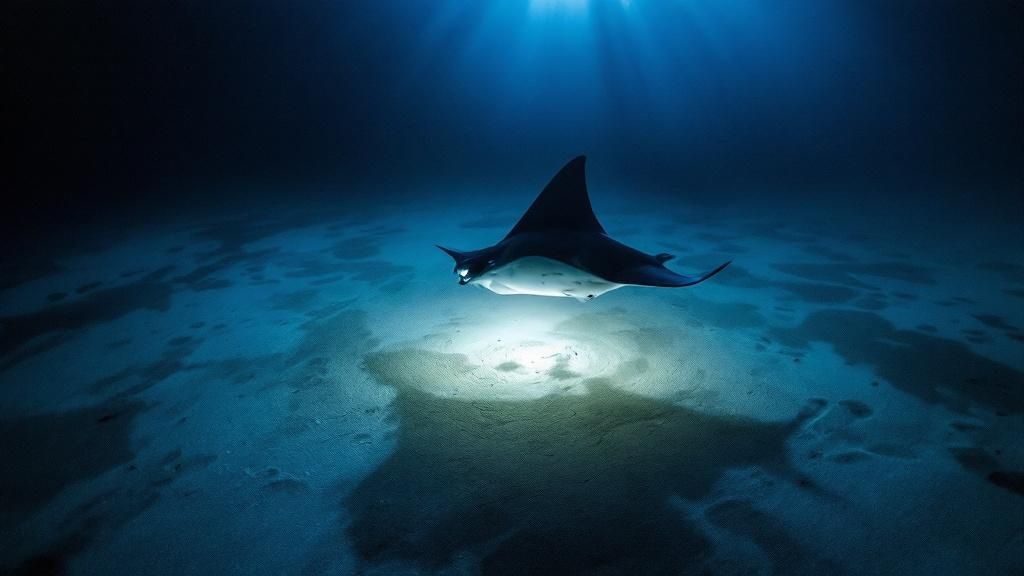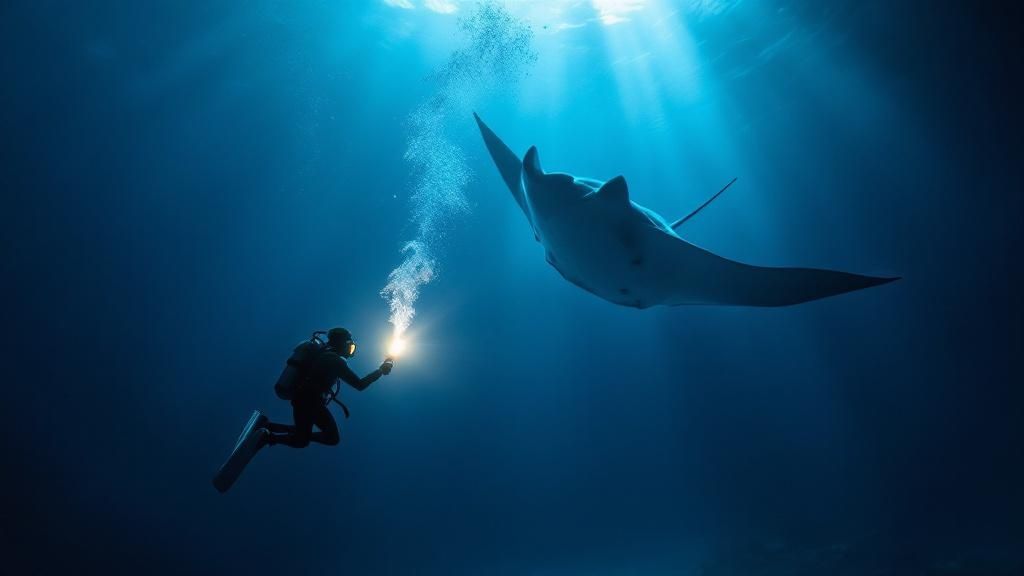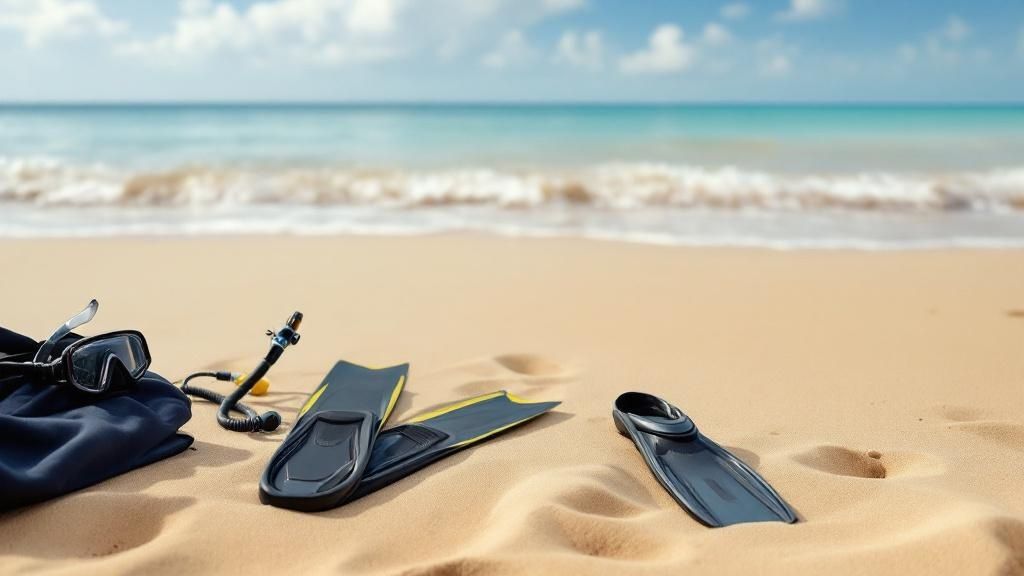Picture this: you’re sinking into the warm, dark waters of the Pacific. Then, out of the blue, graceful giants with wingspans wider than a car glide silently all around you. This isn't a scene from a sci-fi movie—it's the Kona Manta Ray Night Dive, and it’s hands-down one of the most reliable and mesmerizing wildlife encounters you can have anywhere on the planet.
Why Kona Is the Ultimate Manta Ray Destination

So, what makes the Big Island the undisputed champion for seeing these gentle giants? It really comes down to a perfect storm of reliable sightings and a sustainable viewing method that’s been perfected over years. While other spots around the world offer manta encounters, they can be hit-or-miss. Kona, on the other hand, delivers a dependable spectacle pretty much every single night.
This guide is your complete playbook for planning this incredible adventure. I’ll walk you through everything you need to know, from picking the best dive site to interacting safely and responsibly with these majestic creatures. By the end, you'll have the confidence to book the manta ray dive in Kona that you'll be talking about for the rest of your life.
To give you a quick snapshot of what to expect, here are the key details at a glance.
Kona Manta Ray Dive At a Glance
| Aspect | Details |
|---|---|
| Annual Visitors | Approximately 80,000 people participate in tours each year. |
| Peak Season | April to October offer the most ideal conditions. |
| Water Temperature | A comfortable 75–80°F during peak season. |
| Average Sightings | Expect to see an average of 8 to 12 mantas per experience. |
| Primary Dive Sites | Manta Village (Keauhou Bay) and Manta Heaven (near the airport). |
This table should help you start planning, but there's a lot more that goes into making this experience truly unforgettable.
A Thriving Hub for Marine Encounters
The Kona coast has become a global hotspot for this very specific activity, creating a vibrant ecosystem for both the mantas and the dive community. The numbers alone tell a powerful story. Seeing around 80,000 people come here for manta tours every year really cements its reputation.
The consistency of the manta ray dive in Kona isn't magic. It's the result of decades of operators fine-tuning their approach and building a symbiotic relationship with the local manta population.
Beyond the Manta Dive
This incredible spectacle is just one piece of what makes the Big Island a world-class destination for anyone who loves the ocean. The same pristine conditions that allow the mantas to thrive also create amazing opportunities for other adventures. While the manta dive is a must-do, don't forget that Kona offers so much more. For another unforgettable day on the water, check out the ultimate guide to Captain Cook Kona snorkeling.
Understanding the Science Behind the Magic

The feeling you get watching these massive, graceful creatures appear out of the darkness is pure magic. But what makes the manta ray dive kona experience so incredibly reliable isn't magic at all—it’s actually a beautiful example of simple marine biology. It’s not some happy accident; it’s a perfectly understood relationship that operators here have ethically fine-tuned for decades.
It all boils down to one simple ingredient: light.
Think of the powerful underwater lights we use as a giant dinner bell for the ocean. In the vast darkness, these bright beams attract swarms of microscopic critters called zooplankton. This is the main course for Kona’s reef mantas, and our lights create a concentrated, all-you-can-eat buffet in one very convenient spot.
This simple act transforms an ordinary patch of ocean into a five-star manta restaurant, night after night. Mantas are smart, and they've learned that where there are lights, there's a reliable feast. This learned behavior is the secret sauce that makes the Kona encounter one of the most consistent and breathtaking wildlife viewings on the planet.
The Manta Ray Feeding Ballet
When the mantas show up, you’re in for a treat. You'll get a front-row seat to their elegant feeding technique, known as filter-feeding. They don’t have teeth for chewing; instead, their gills have specialized plates that work like a giant sieve.
They glide through the plankton-filled water with their enormous mouths wide open, filtering out their meal while the water passes right through. To get every last bit, they perform some seriously graceful acrobatics.
- Barrel Rolls: You’ll see them do these mesmerizing backward somersaults. This isn't just for show—it allows them to stay right in the thickest part of the plankton cloud and scoop up as much food as possible.
- Gliding Passes: They’ll also make these slow, elegant passes directly through the beams of light, sometimes coming within inches of us on the seafloor.
It's a truly beautiful, symbiotic relationship. The lights draw in the plankton, the plankton draws in the mantas, and the mantas create an unforgettable show for us. It’s a sustainable interaction that doesn’t harm the animals or their home.
A Sustainable and Respectful Practice
Knowing the science behind the spectacle just makes you appreciate it more. Operators in Kona have worked tirelessly to perfect this method, ensuring it’s done with the utmost respect and doesn’t disrupt the mantas' natural behavior outside this specific feeding time. We aren't baiting them with foreign food; the lights simply concentrate what’s already there.
This commitment to ethical tourism ensures our local manta population, with over 300 identified individuals, continues to thrive. To get a really detailed, first-hand account of this incredible interaction, you can read more about what it’s like to go on the manta ray dive in Kona, Hawaii.
When you understand the "how" and "why" behind this ballet of light and life, you'll have a much deeper appreciation for the incredible show you're about to witness.
Choosing Your Dive Site: Manta Village Vs. Manta Heaven

When you're planning your Kona manta ray dive, you’ll quickly find there are two main "stages" for this incredible underwater show. The site you pick will absolutely shape your experience, so it pays to know the personality of each spot. It’s like choosing between a cozy, intimate theater and a grand, open-air arena—both feature a spectacular performance, but the vibe is completely different.
The two go-to sites are Manta Village (down by Keauhou Bay) and Manta Heaven (up near the Kona Airport). While both locations boast a sighting success rate of over 90%, they offer very different dives for different kinds of people. Getting this choice right is your first step to an unforgettable night.
Manta Village: The Welcoming Favorite
Manta Village is often called the original and most dependable manta ray spot in Kona. It's just a quick boat trip from Keauhou Bay, which is a huge plus if you or someone in your group gets seasick easily. The water here is usually calmer and shallower, with depths around 25 to 35 feet.
This makes it a fantastic choice for:
- First-time night divers looking for a gentle and controlled introduction.
- Snorkelers of all ages and swimming abilities.
- Families who want a more predictable and sheltered experience.
The bottom is mostly sand, which creates a natural "stadium" where divers can comfortably settle in and watch the ballet unfold overhead. The only trade-off is that its accessibility can sometimes make it the busier of the two sites. Still, for consistency and ease, it's a stellar and reliable option.
Manta Heaven: The Adventurous Outlier
If Manta Village is the cozy theater, Manta Heaven is the wild, untamed arena. Located further offshore near the airport (it’s known as Garden Eel Cove by day), this site is noticeably deeper, with the sandy bottom sitting around 40 to 50 feet. It's also more exposed to the open ocean, meaning you're more likely to experience currents and surge.
This spot tends to be a magnet for more experienced divers who are comfortable in dynamic conditions. That bit of extra water movement can sometimes draw in an even greater number of mantas, creating a truly electrifying performance. It's a raw, unfiltered encounter with nature at its most impressive.
Your choice really boils down to your personal comfort zone. Are you after a calm, predictable setting, or are you craving a more adventurous and dynamic dive where anything can happen?
A Direct Comparison
To help you decide which spot is the right fit for your manta ray dive in Kona, let’s put them side-by-side.
Manta Village vs. Manta Heaven Comparison
| Feature | Manta Village (Keauhou Bay) | Manta Heaven (near Airport) |
|---|---|---|
| Location | South of Kona, near Sheraton Resort | North of Kona, near the airport |
| Water Depth | Shallower (25-35 feet) | Deeper (40-50 feet) |
| Typical Conditions | Calm, protected, less current | More exposed, potential for current |
| Best For | Beginners, snorkelers, families | Experienced divers, adventure seekers |
| Accessibility | Shorter boat ride | Longer boat ride |
| Vibe | Intimate and predictable | Dynamic and adventurous |
Honestly, you can't go wrong. Both sites deliver the kind of memories that last a lifetime. Knowing these differences is a key part of understanding why you should go on a manta ray dive in Kona—it lets you tailor the adventure perfectly to your own style.
How to Prepare for Your Manta Ray Adventure

A little prep work can be the difference between a good trip and an absolutely incredible one. When you're planning your manta ray dive kona experience, a bit of foresight ensures you're comfortable, safe, and ready to just soak in the magic without a single worry. Think of it like a pre-flight checklist for one of the world's best underwater shows.
Let’s start with the easy stuff. After you get out of the water, the boat ride back to the harbor can feel pretty chilly at night. You’ll be glad you packed a dry towel and something warm—a simple hoodie or a windbreaker makes all the difference. Also, don't underestimate the Hawaiian sun, even on a sunset tour. Slather on some reef-safe sunscreen before you head out.
Choosing a Responsible Operator
What you pack is important, but the single most critical decision you'll make is which tour operator to go with. This choice has a direct impact on your safety and, just as importantly, the well-being of the manta rays themselves.
You'll want to look for companies on the "Manta Ray Green Listed" directory or ones that are very clear about their commitment to sustainable, eco-friendly practices. These are the operators who follow strict guidelines to make sure the encounter is respectful to the animals and doesn't disrupt their natural behavior.
Choosing a certified, eco-conscious operator is the single best way to ensure your adventure supports the long-term health of Kona's manta ray population. Your decision contributes directly to the sustainability of this incredible natural wonder.
The manta viewing industry is a massive part of Kona's local economy. Dive sites like Manta Village in Keauhou Bay offer such reliable, amazing encounters—thanks to calm waters and easy boat access—that it's become a cornerstone for the island. When you choose a responsible operator, you're helping protect this vital piece of Kona's identity, a topic covered in detail by the state’s safety assessment of these operations.
Key Questions to Ask Before You Book
Knowing the right questions to ask is your best tool for vetting a company and feeling confident in your choice. Don't be shy about calling up a potential dive shop and getting some details before you hand over your credit card.
Here’s a quick checklist of what to ask:
- Safety Record & Crew Experience: How long have they been running these tours? What are their safety procedures and how experienced is the crew?
- Manta Guarantee: What happens if the mantas don't show up? (It's rare, but it can happen). Good operators will usually let you rebook for free on another night.
- Group Size: How many people do they put in the water per guide? Smaller groups almost always mean a better, more personal, and less chaotic experience.
- Included Gear: Is a wetsuit included in the price, or is that an extra rental fee? It's good to know the full cost upfront.
It’s a really good idea to book your manta ray dive in Kona far in advance. This is especially true if you’re visiting during the peak season, which runs from about April to October. The best operators get booked up fast, so locking in your spot early means you won't miss out on this absolute bucket-list adventure.
Responsible Interaction and Safety Rules
When you slip into the water for your manta ray dive in Kona, you’re stepping into their world. Imagine you've been invited to a magnificent underwater dinner party. The best way to act is as a quiet, respectful observer. You're there to witness the magic, not to become the center of attention.
The golden rule, the one that trumps all others, is passive observation. This isn't just a friendly suggestion; it’s the cornerstone of protecting these gentle giants and making sure this incredible encounter remains for future generations. Touching a manta ray can strip away the protective mucus layer on their skin, which is like us losing our immune system—it leaves them dangerously vulnerable to infections.
So, a simple rule of thumb is to never touch, chase, or even think about trying to ride a manta. It's also crucial to avoid swimming right over the top of them. This can break their graceful feeding rhythm, causing them to bolt and effectively ending the "dinner party" for everyone in the water.
Manta Interaction Golden Rules
Every reputable dive operator will have a strict set of rules to keep both you and the mantas safe. You'll get a thorough briefing before your dive, but the main ideas are refreshingly simple. Just picture yourself as part of the scenery—a rock or a piece of coral—not an active participant in the show.
Here’s what that looks like in the water:
- Stay Stationary: Divers will find a spot on the sandy bottom, while snorkelers will hold onto a specially designed floating raft. This isn't the time for free-swimming.
- Keep Fins Down: Keep your fins low and your kicks minimal. This prevents stirring up sand, which clouds the water, and avoids accidentally bumping a manta or other sea life.
- Lights Point Up: If you’re a diver, your light should shine straight up toward the surface. This creates a beacon that attracts the plankton. For snorkelers, your lights will shine down from the raft.
- Avoid Exhaling Bubbles in Their Path: This is a pro tip for divers. Try to time your breathing so you don't release a big cloud of bubbles right as a manta is gliding gracefully overhead.
These rules are not just suggestions; they are the foundation of a sustainable and ethical wildlife encounter. By following them, you play an active role in protecting Kona's cherished manta ray population.
Sticking to these protocols is what makes the whole experience possible. For a deeper dive into what to expect and how to get ready, you can learn more about what you should know about the manta ray dive in Kona before you even pack your bags. This shared commitment is what ensures a safe, respectful, and truly unforgettable adventure for everyone.
Tips for Capturing Incredible Underwater Photos
Let's be honest: shooting the legendary manta ray dive in Kona is as much a challenge as it is a thrill. You're dealing with low light and subjects that never stop moving. But when you nail that one shot—capturing the graceful, otherworldly dance of these giants—it's a feeling no photographer ever forgets.
Success really starts before you even hit the water. It’s all about the gear. Your first instinct might be to grab a standard camera strobe, but I'd advise against it. The harsh, quick flash can be really disruptive to the mantas. A much better tool for the job is a powerful, wide-beam video light. It paints the whole scene with a softer, more even light without startling our stars of the show.
Essential Camera and Lighting Tips
A wide-angle lens is non-negotiable. It’s the only way to get close enough to the action while still fitting those immense wingspans into the frame. If you try to shoot with a narrow lens, you’ll just end up frustrated, constantly trying to back up to capture the whole spectacle.
When it comes to settings, you’ll want to be in full manual mode. Here’s a good starting point:
- ISO: Start somewhere between 800-1600. You can tweak this depending on how well your camera handles low-light situations.
- Aperture: Open that aperture up as wide as it will go (think f/2.8 or similar) to drink in every bit of available light.
- Shutter Speed: To freeze the mantas' fluid motion and avoid a blurry mess, you'll want to be at 1/125s or faster.
The real secret weapon, though? Mastering your buoyancy. If you can stay perfectly still on the seafloor, you basically become a human tripod. This minimizes camera shake and lets the mantas get comfortable enough to come right up to you.
Beyond the Lens
Sometimes, the smartest thing a photographer can do is to put the camera down. Just for a minute. Let yourself get lost in the moment and simply watch the silent ballet unfold. It's not just about soaking in the experience (which is reason enough!); it also gives you a better feel for the rhythm of the dive, helping you anticipate the perfect shot for your next attempt. Diving into broader topics on great underwater experiences can give you even more perspective to bring to your craft.
Here in Kona, we have a massive home-field advantage. A long-term study showed that we see an average of 20 manta sightings per night. Even better for photographers, our average water visibility is around 100 feet, which is heads and shoulders above other manta hotspots around the globe. That kind of clarity is a gift.
To get the full picture of what makes this dive so unique, be sure to check out our complete guide on the Big Island manta ray night dive.
Frequently Asked Questions About the Kona Manta Dive
It's totally normal to have a few lingering questions before the big night, no matter how much you've planned. We get it. Here are some straight-up answers to the most common questions we hear, so you can feel completely ready for the experience.
What If No Mantas Show Up?
This is probably the number one question on everyone's mind, but honestly, you can relax. The Kona coast has a manta ray sighting success rate of over 90% all year long. A complete no-show is incredibly rare.
That said, these are wild animals, so a 100% guarantee is never on the table. Any reputable operator knows this and will almost always have a "manta guarantee." If for some reason the mantas don't appear on your tour, you can usually rebook for another night at no extra cost. This is a great reason to schedule your manta dive for early in your trip!
Is There a Best Time of Year to Go?
Nope, there isn't really a "manta season" here in Kona. Our local reef mantas are residents—they don't migrate. They show up for their plankton buffet every single night of the year.
While the mantas are always around, the ocean conditions are definitely at their best from late spring to early fall, think April through October. During these months, the seas are usually much calmer and the water is warmer, which just makes for a more comfortable and pleasant time for everyone.
Can I Touch the Manta Rays?
Absolutely not. This is the single most important rule of the manta ray dive in Kona. Manta rays are coated in a thin mucus layer that is basically their immune system. Touching them, even with the lightest graze, can wipe off this protective slime and leave them wide open to dangerous bacterial infections.
Think of it as a strict "look, don't touch" policy. We are just guests in their underwater dining room. The best thing we can do is observe passively to keep these gentle giants safe and healthy for years to come.
Is It Safe to Swim with Manta Rays?
Yes, it is completely safe. Despite their intimidating size, manta rays are gentle giants—true filter-feeders that pose zero threat to people. They are part of the ray family, but they have no teeth, no stinger, and no barb on their tail. The only interest they might have in us is a bit of mild curiosity.
For a deeper dive into this amazing encounter, check out our full guide to the manta ray night dive in Kona, Hawaii.
Ready to witness the manta ballet for yourself? Kona Honu Divers offers world-class, eco-conscious tours led by the most experienced crew on the island. Book your unforgettable manta ray adventure today!
